15.3E: Exercises for Section 15.3
( \newcommand{\kernel}{\mathrm{null}\,}\)
Terms and Concepts
1. When evaluating ∫∫Rf(x,y)dA using polar coordinates, f(x,y) is replaced with _______ and dA is replaced with _______.
- Answer
- f(x,y) is replaced with f(rcosθ,rsinθ) and dA is replaced with rdrdθ.
2. Why would one be interested in evaluating a double integral with polar coordinates?
Defining Polar Regions
In exercises 3 - 6, express the region R in polar coordinates.
3) R is the region of the disk of radius 2 centered at the origin that lies in the first quadrant.
- Answer
- R={(r,θ)|0≤r≤2, 0≤θ≤π2}
4) R is the region of the disk of radius 3 centered at the origin.
5) R is the region between the circles of radius 4 and radius 5 centered at the origin that lies in the second quadrant.
- Answer
- R={(r,θ)|4≤r≤5, π2≤θ≤π}
6) R is the region bounded by the y-axis and x=√1−y2.
7) R is the region bounded by the x-axis and y=√2−x2.
- Answer
- R={(r,θ)|0≤r≤√2, 0≤θ≤π}
8) R={(x,y)|x2+y2≤4x}
9) R={(x,y)|x2+y2≤4y}
- Answer
- R={(r,θ)|0≤r≤4 sinθ, 0≤θ≤π}
In exercises 10 - 15, the graph of the polar rectangular region D is given. Express D in polar coordinates. In exercises 10 - 13 the regions are bounded by circles centered at the origin, the coordinate axes, and/or lines of the form y=±x (each of which should be able to be identified by inspection).
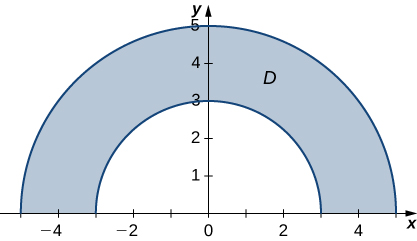
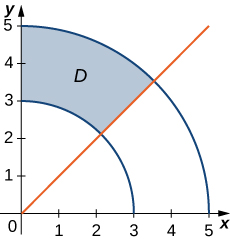
- Answer
- D={(r,θ)|3≤r≤5, π4≤θ≤π2}
12)
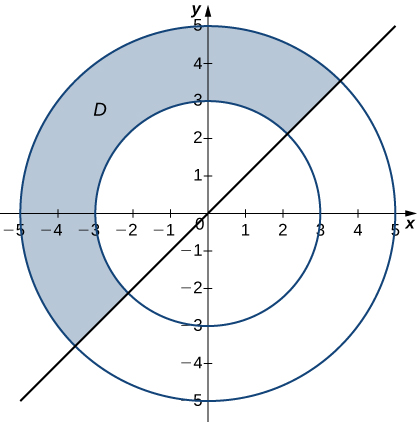
13)
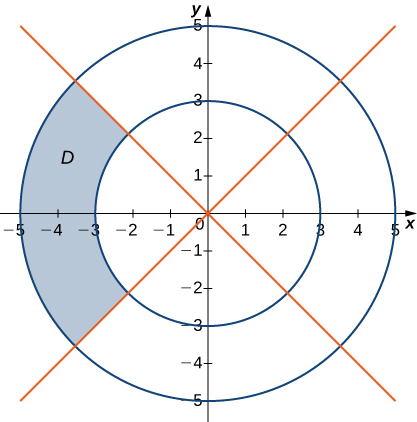
- Answer
- D={(r,θ)|3≤r≤5, 3π4≤θ≤5π4}
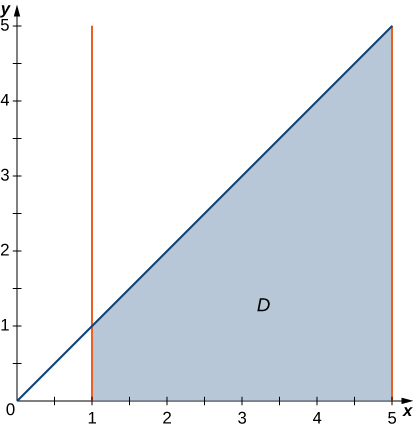
15) In the following graph, the region D is bounded by y=x and y=x2.
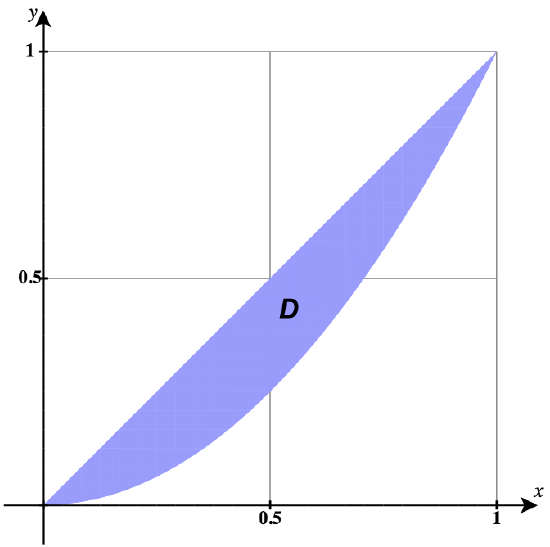
- Answer
- D={(r,θ)|0≤r≤tanθ secθ, 0≤θ≤π4}
Evaluating Polar Double Integrals
In exercises 16 - 25, evaluate the double integral ∬Rf(x,y)dA over the polar rectangular region R.
16) f(x,y)=x2+y2, R={(r,θ)|3≤r≤5, 0≤θ≤2π}
17) f(x,y)=x+y, R={(r,θ)|3≤r≤5, 0≤θ≤2π}
- Answer
- 0
18) f(x,y)=x2+xy, R={(r,θ)|1≤r≤2, π≤θ≤2π}
19) f(x,y)=x4+y4, R={(r,θ)|1≤r≤2, 3π2≤θ≤2π}
- Answer
- 63π16
20) f(x,y)=3√x2+y2, where R={(r,θ)|0≤r≤1, π2≤θ≤π}.
21) f(x,y)=x4+2x2y2+y4, where R={(r,θ)|3≤r≤4, π3≤θ≤2π3}.
- Answer
- 3367π18
22) f(x,y)=sin(arctanyx), where R={(r,θ)|1≤r≤2, π6≤θ≤π3}
23) f(x,y)=arctan(yx), where R={(r,θ)|2≤r≤3, π4≤θ≤π3}
- Answer
- 35π2576
24) ∬Rex2+y2[1+2 arctan(yx)]dA, R={(r,θ)|1≤r≤2, π6≤θπ3}
25) ∬R(ex2+y2+x4+2x2y2+y4)arctan(yx)dA, R={(r,θ)|1≤r≤2, π4≤θ≤π3}
- Answer
- 7576π2(21−e+e4)
Converting Double Integrals to Polar Form
In exercises 26 - 29, the integrals have been converted to polar coordinates. Verify that the identities are true and choose the easiest way to evaluate the integrals, in rectangular or polar coordinates.
26) ∫21∫x0(x2+y2)dy dx=∫π40∫2 secθsecθr3dr dθ
27) ∫32∫x0x√x2+y2dy dx=∫π/40∫3secθ2secθr cosθ dr dθ
- Answer
- 52ln(1+√2)
28) ∫10∫xx21√x2+y2dy dx=∫π/40∫tanθ secθ0 dr dθ
29) ∫10∫xx2y√x2+y2dy dx=∫π/40∫tanθ secθ0r sinθ dr dθ
- Answer
- 16(2−√2)
In exercises 30 - 37, draw the region of integration, R, labeling all limits of integration, convert the integrals to polar coordinates and evaluate them.
30) ∫30∫√9−y20(x2+y2)dx dy
31) ∫20∫√4−y2−√4−y2(x2+y2)2dx dy
- Answer
- ∫π0∫20r5dr dθ=32π3
32) ∫10∫√1−x20(x+y) dy dx
33) ∫40∫√16−x2−√16−x2sin(x2+y2) dy dx
- Answer
- ∫π/2−π/2∫40r sin(r2) dr dθ=π sin28
34) ∫50∫√25−x2−√25−x2√x2+y2dydx
35) ∫4−4∫0−√16−y2(2y−x)dxdy
- Answer
- ∫3π2π2∫40(2rsinθ−rcosθ)rdr dθ=1283
36) ∫20∫√8−y2y(x+y)dxdy
37) ∫−1−2∫√4−x20(x+5)dydx+∫1−1∫√4−x2√1−x2(x+5)dydx+∫21∫√4−x20(x+5)dydx
- Answer
- ∫π0∫21(rcosθ+5)rdr dθ=15π2
38) Evaluate the integral ∬DrdA where D is the region bounded by the polar axis and the upper half of the cardioid r=1+cosθ.
39) Find the area of the region D bounded by the polar axis and the upper half of the cardioid r=1+cosθ.
- Answer
- 3π4
40) Evaluate the integral ∬DrdA, where D is the region bounded by the part of the four-leaved rose r=sin2θ situated in the first quadrant (see the following figure).
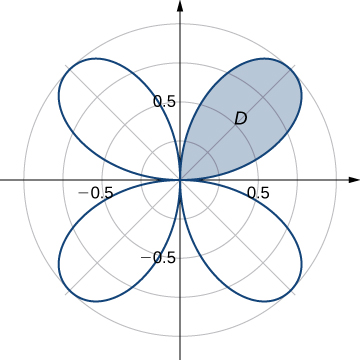
41) Find the total area of the region enclosed by the four-leaved rose r=sin2θ (see the figure in the previous exercise).
- Answer
- π2
42) Find the area of the region D which is the region bounded by y=√4−x2, x=√3, x=2, and y=0.
43) Find the area of the region D, which is the region inside the disk x2+y2≤4 and to the right of the line x=1.
- Answer
- 13(4π−3√3)
44) Determine the average value of the function f(x,y)=x2+y2 over the region D bounded by the polar curve r=cos2θ, where −π4≤θ≤π4 (see the following graph).
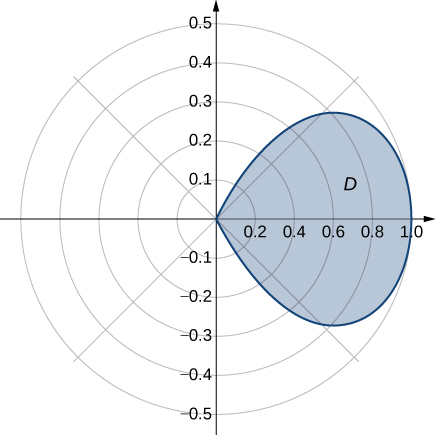
45) Determine the average value of the function f(x,y)=√x2+y2 over the region D bounded by the polar curve r=3sin2θ, where 0≤θ≤π2 (see the following graph).
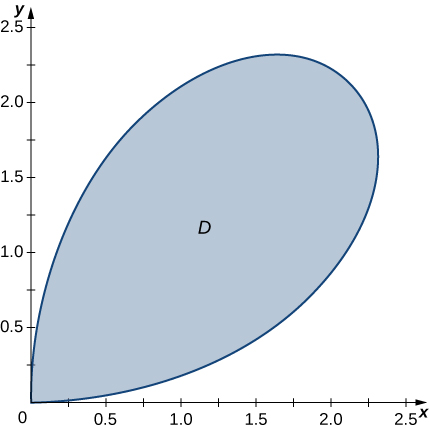
- Answer
- 163π
46) Find the volume of the solid situated in the first octant and bounded by the paraboloid z=1−4x2−4y2 and the planes x=0, y=0, and z=0.
47) Find the volume of the solid bounded by the paraboloid z=2−9x2−9y2 and the plane z=1.
- Answer
- π18
48)
- Find the volume of the solid S1 bounded by the cylinder x2+y2=1 and the planes z=0 and z=1.
- Find the volume of the solid S2 outside the double cone z2=x2+y2 inside the cylinder x2+y2=1, and above the plane z=0.
- Find the volume of the solid inside the cone z2=x2+y2 and below the plane z=1 by subtracting the volumes of the solids S1 and S2.
49)
- Find the volume of the solid S1 inside the unit sphere x2+y2+z2=1 and above the plane z=0.
- Find the volume of the solid S2 inside the double cone (z−1)2=x2+y2 and above the plane z=0.
- Find the volume of the solid outside the double cone (z−1)2=x2+y2 and inside the sphere x2+y2+z2=1.
- Answer
- a. 2π3; b. π2; c. π6
In Exercises 50-51, special double integrals are presented that are especially well suited for evaluation in polar coordinates.
50) The surface of a right circular cone with height h and base radius a can be described by the equation f(x,y)=h−h√x2a2+y2a2, where the tip of the cone lies at (0,0,h) and the circular base lies in the xy-plane, centered at the origin.
Confirm that the volume of a right circular cone with height h and base radius a is V=13πa2h by evaluating ∫∫Rf(x,y)dA in polar coordinates.
51) Consider ∫∫Re−(x2+y2)dA.
(a) Why is this integral difficult to evaluate in rectangular coordinates, regardless of the region R?
(b) Let R be the region bounded by the circle of radius a centered at the origin. Evaluate the double integral using polar coordinates.
(c) Take the limit of your answer from (b), as a→∞. What does this imply about the volume under the surface of e−(x2+y2) over the entire xy-plane?
For the following two exercises, consider a spherical ring, which is a sphere with a cylindrical hole cut so that the axis of the cylinder passes through the center of the sphere (see the following figure).

52) If the sphere has radius 4 and the cylinder has radius 2 find the volume of the spherical ring.
53) A cylindrical hole of diameter 6 cm is bored through a sphere of radius 5 cm such that the axis of the cylinder passes through the center of the sphere. Find the volume of the resulting spherical ring.
- Answer
- 256π3 cm3
54) Find the volume of the solid that lies under the double cone z2=4x2+4y2, inside the cylinder x2+y2=x, and above the plane z=0.
55) Find the volume of the solid that lies under the paraboloid z=x2+y2, inside the cylinder x2+y2=1 and above the plane z=0.
- Answer
- 3π32
56) Find the volume of the solid that lies under the plane x+y+z=10 and above the disk x2+y2=4x.
57) Find the volume of the solid that lies under the plane 2x+y+2z=8 and above the unit disk x2+y2=1.
- Answer
- 4π
58) A radial function f is a function whose value at each point depends only on the distance between that point and the origin of the system of coordinates; that is, f(x,y)=g(r), where r=√x2+y2. Show that if f is a continuous radial function, then
∬Df(x,y)dA=(θ2−θ1)[G(R2)−G(R1)], where G′(r)=rg(r) and (x,y)∈D={(r,θ)|R1≤r≤R2, 0≤θ≤2π}, with 0≤R1<R2 and 0≤θ1<θ2≤2π.
59) Use the information from the preceding exercise to calculate the integral ∬D(x2+y2)3dA, where D is the unit disk.
- Answer
- π4
60) Let f(x,y)=F′(r)r be a continuous radial function defined on the annular region D={(r,θ)|R1≤r≤R2, 0≤θ≤2π}, where r=√x2+y2, 0<R1<R2, and F is a differentiable function.
Show that ∬Df(x,y)dA=2π[F(R2)−F(R1)].
61) Apply the preceding exercise to calculate the integral ∬De√x2+y2√x2+y2dx dy where D is the annular region between the circles of radii 1 and 2 situated in the third quadrant.
- Answer
- 12πe(e−1)
62) Let f be a continuous function that can be expressed in polar coordinates as a function of θ only; that is, f(x,y)=h(θ), where (x,y)∈D={(r,θ)|R1≤r≤R2, θ1≤θ≤θ2}, with 0≤R1<R2 and 0≤θ1<θ2≤2π.
Show that ∬Df(x,y)dA=12(R22−R21)[H(θ2)−H(θ1)], where H is an antiderivative of h.
63) Apply the preceding exercise to calculate the integral ∬Dy2x2dA, where D={(r,θ)|1≤r≤2, π6≤θ≤π3}.
- Answer
- √3−π4
64) Let f be a continuous function that can be expressed in polar coordinates as a function of θ only; that is f(x,y)=g(r)h(θ), where (x,y)∈{(r,θ)|R1≤r≤R2, θ1≤θ≤θ2} with 0≤R1<R2 and 0≤θ1<θ2≤2π. Show that ∬Df(x,y)dA=[G(R2)−G(R1)] [H(θ2)−H(θ1)], where G and H are antiderivatives of g and h, respectively.
65) Evaluate ∬Darctan(yx)√x2+y2dA, where D={(r,θ)|2≤r≤3, π4≤θ≤π3}.
- Answer
- 133864π2
66) A spherical cap is the region of a sphere that lies above or below a given plane.
a. Show that the volume of the spherical cap in the figure below is 16πh(3a2+h2).
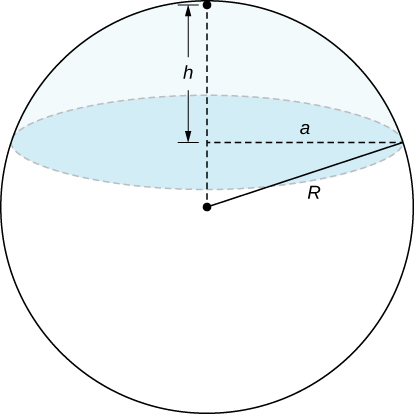
b. A spherical segment is the solid defined by intersecting a sphere with two parallel planes. If the distance between the planes is h show that the volume of the spherical segment in the figure below is 16πh(3a2+3b2+h2).
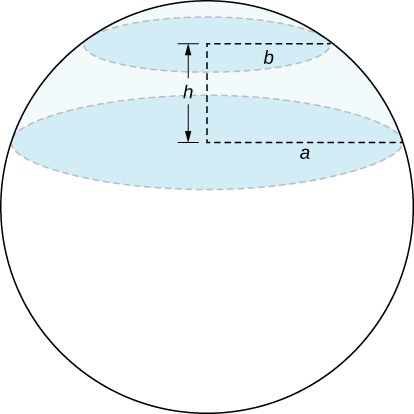
67) In statistics, the joint density for two independent, normally distributed events with a mean μ=0 and a standard distribution σ is defined by p(x,y)=12πσ2e−x2+y22σ2. Consider (X,Y), the Cartesian coordinates of a ball in the resting position after it was released from a position on the z-axis toward the xy-plane. Assume that the coordinates of the ball are independently normally distributed with a mean μ=0 and a standard deviation of σ (in feet). The probability that the ball will stop no more than a feet from the origin is given by P[X2+Y2≤a2]=∬Dp(x,y)dy dx, where D is the disk of radius a centered at the origin. Show that P[X2+Y2≤a2]=1−e−a2/2σ2.
68) The double improper integral ∫∞−∞∫∞−∞e−x2+y2/2dydx may be defined as the limit value of the double integrals ∬De−x2+y2/2dA over disks Da of radii a centered at the origin, as a increases without bound; that is,
∫∞−∞∫∞−∞e−x2+y2/2dy dx=lim
Use polar coordinates to show that \displaystyle \int_{-\infty}^{\infty} \int_{-\infty}^{\infty} e^{-x^2+y^2/2}\,dy \, dx = 2\pi.
69) Show that \displaystyle \int_{-\infty}^{\infty} e^{-x^2/2}\,dx = \sqrt{2\pi} by using the relation
\int_{-\infty}^{\infty} \int_{-\infty}^{\infty} e^{-x^2+y^2/2}\,dy \,dx = \left(\int_{-\infty}^{\infty} e^{-x^2/2}dx \right) \left( \int_{-\infty}^{\infty} e^{-y^2/2}dy \right). \nonumber
Contributors
Gilbert Strang (MIT) and Edwin “Jed” Herman (Harvey Mudd) with many contributing authors. This content by OpenStax is licensed with a CC-BY-SA-NC 4.0 license. Download for free at http://cnx.org.
- Problems 1, 2, 34 - 37 and 50 - 51 are from Apex Calculus, Chapter 13.3
- Edited by Paul Seeburger (Monroe Community College)

